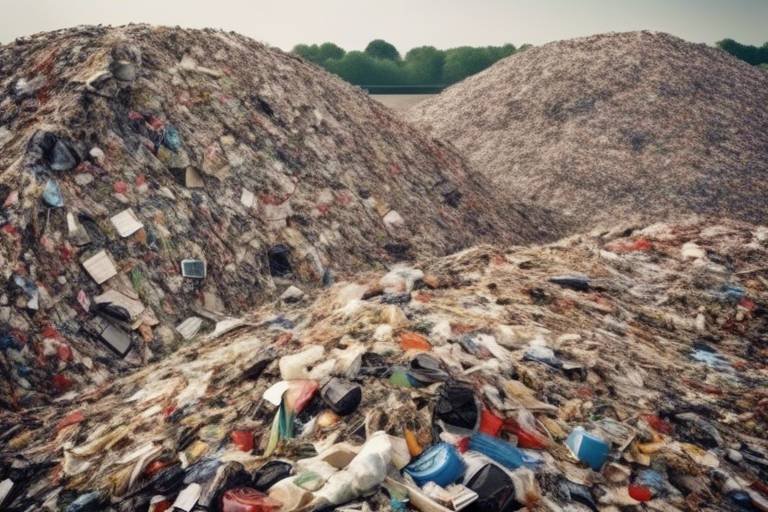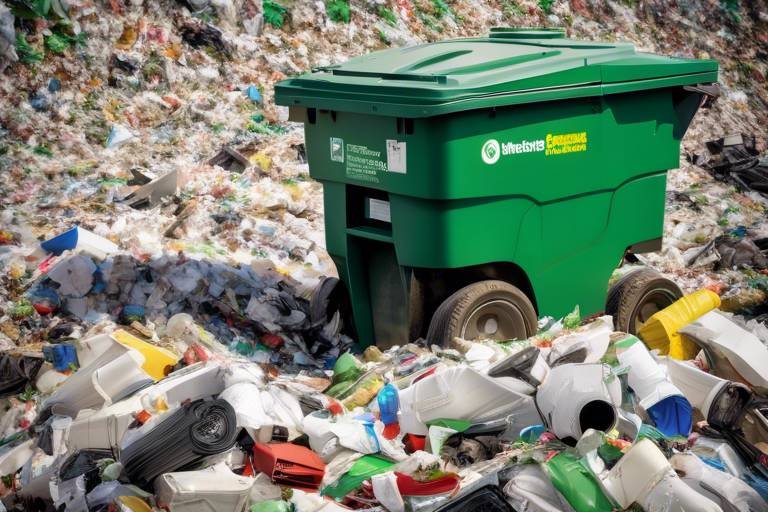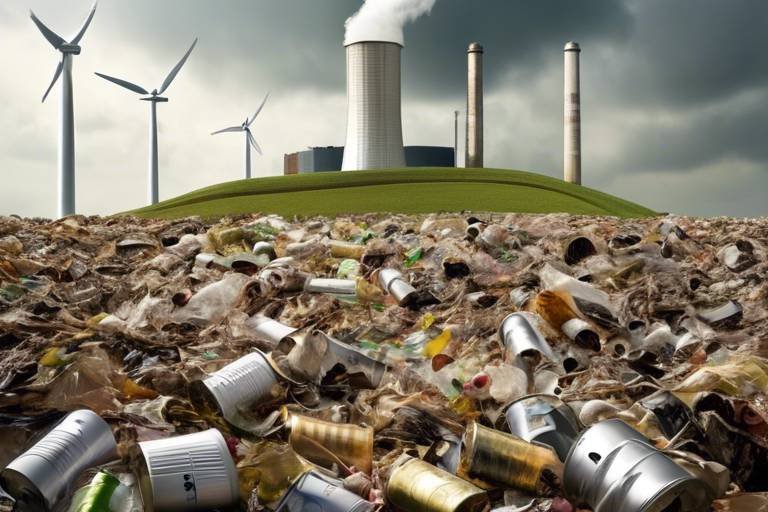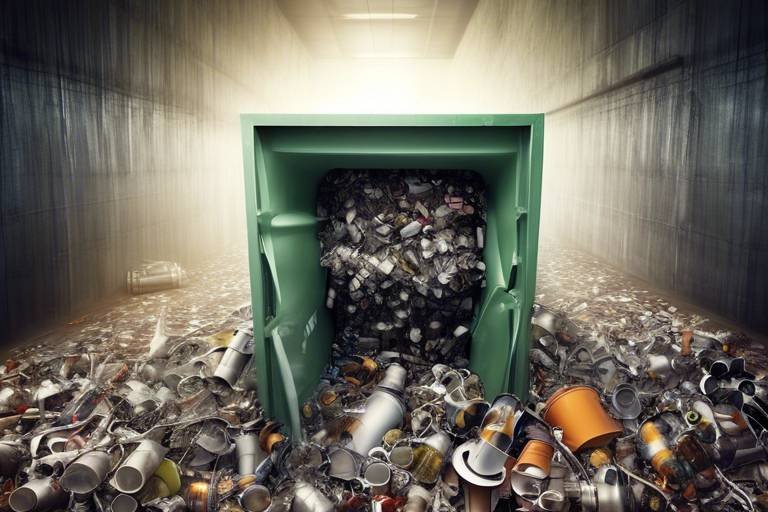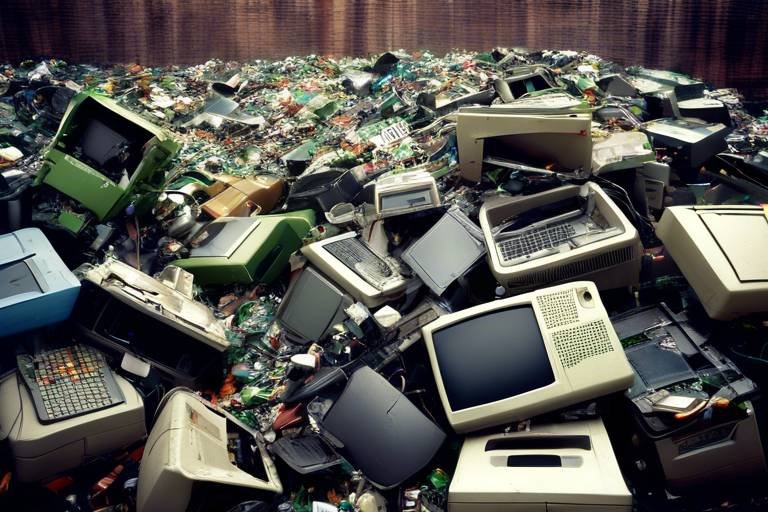The Role of Landfills in Modern Society
In today's fast-paced world, the management of waste has become a critical issue that affects our daily lives, our environment, and our future. Landfills, often seen as a necessary evil, play a significant role in the waste management hierarchy. They are not just dumping grounds; they are complex systems that must be carefully designed and operated to handle the increasing amount of waste generated by our society. With urbanization and population growth, the volume of waste continues to rise, making the role of landfills even more crucial.
Landfills serve as a solution for disposing of waste that cannot be recycled or reused. They provide a means to manage waste safely while minimizing its impact on the environment. However, this role comes with its own set of challenges. As we strive for a more sustainable future, it is essential to understand the importance of landfills in the context of waste management, environmental protection, and community health.
One of the most pressing concerns regarding landfills is their environmental impact. They can contribute to greenhouse gas emissions, particularly methane, which is significantly more potent than carbon dioxide. This raises questions about how we can improve landfill operations to mitigate these emissions. Furthermore, the risk of groundwater contamination from leachate—a toxic liquid that can seep from waste—poses a threat to our water resources, making effective monitoring and management vital.
Despite these challenges, landfills are evolving. Innovations in landfill management, such as waste-to-energy technologies and improved recycling initiatives, are paving the way for a more sustainable approach. These advancements not only reduce the volume of waste sent to landfills but also create opportunities for energy recovery and resource conservation. As communities become more aware of their environmental footprint, the emphasis on reducing reliance on landfills is growing.
In conclusion, while landfills may not be the most glamorous aspect of waste management, their role in modern society is undeniably important. They are a necessary component of our waste disposal system, providing a solution for waste that cannot be diverted. As we continue to innovate and improve landfill practices, we can work towards a future where landfills are managed more sustainably, ultimately benefiting both people and the planet.
- What is a landfill? A landfill is a designated area for the disposal of waste where it is buried and managed to minimize environmental impact.
- How do landfills impact the environment? Landfills can contribute to greenhouse gas emissions and pose risks of groundwater contamination.
- What are waste-to-energy technologies? These technologies convert waste materials into usable energy, reducing the overall volume of waste while providing an alternative energy source.
- How can we reduce the amount of waste sent to landfills? By increasing recycling efforts, composting organic materials, and promoting responsible consumption, we can significantly reduce landfill waste.

The History of Landfills
The concept of landfills dates back centuries, evolving from rudimentary refuse disposal sites to sophisticated waste management facilities. In ancient times, communities often disposed of waste in pits or simply left it in designated areas, which led to unsightly and unsanitary conditions. As populations grew and urban areas expanded, the need for more organized waste disposal became apparent. The introduction of landfills as we know them today began in the 19th century, marking a significant shift in waste management practices.
Initially, landfills were merely sites where waste was buried. However, as awareness of environmental and health issues grew, so did the regulations surrounding landfill operations. The 20th century saw a surge in industrialization and consumerism, which in turn increased the volume and complexity of waste generated. This led to the development of more structured landfill designs aimed at minimizing environmental impact. For instance, the implementation of liners and leachate collection systems became crucial in preventing soil and groundwater contamination.
By the late 1970s and early 1980s, the environmental movement gained momentum, and legislation such as the Resource Conservation and Recovery Act (RCRA) in the United States was enacted. This act established guidelines for the management of hazardous waste and set standards for landfill operations, ensuring that they adhered to safety protocols designed to protect human health and the environment.
Throughout the years, landfills have adapted to meet the changing needs of society. Today, they are not just waste disposal sites; they are complex systems that incorporate technology and engineering to manage waste efficiently. Modern landfills are equipped with gas collection systems that capture methane emissions, which can be harnessed as a renewable energy source. This transformation reflects a broader trend towards sustainability and resource recovery in waste management practices.
To better understand the evolution of landfills, let's take a look at a brief timeline highlighting key developments in landfill history:
| Year | Event |
|---|---|
| 3000 BC | Early civilizations begin to use pits for waste disposal. |
| 19th Century | Formal landfills established in urban areas to manage waste. |
| 1976 | Resource Conservation and Recovery Act (RCRA) enacted in the U.S. |
| 1980s | Introduction of regulations for hazardous waste landfills. |
| 2000s | Implementation of gas collection systems and waste-to-energy technologies. |
As we move forward, the role of landfills continues to evolve, reflecting a growing commitment to environmental stewardship and sustainable waste management practices. The history of landfills is not just a story of waste disposal; it's a narrative of innovation, responsibility, and the ongoing quest for a cleaner, healthier planet.

Types of Landfills
When we think about landfills, it’s easy to assume that they all serve the same purpose. However, the reality is far more complex. Landfills are categorized based on the type of waste they accept and the specific environmental challenges they address. Understanding these different types of landfills is crucial for grasping their roles in waste management and environmental protection. In essence, each landfill type is like a specialized tool in a toolbox, designed to tackle unique waste issues. Let's dive into the primary categories of landfills that play significant roles in our society today.
The most common type is the Municipal Solid Waste (MSW) Landfill, which is designed to handle everyday waste generated by households and businesses. These landfills accept a mix of organic and inorganic materials, from food scraps to plastic containers. The design and operation of MSW landfills focus on efficient waste management practices that minimize environmental impacts. For instance, they often incorporate advanced technologies for leachate management and gas collection systems, which are essential for reducing harmful emissions.
On the other hand, we have Hazardous Waste Landfills. These are engineered to contain toxic materials that pose significant risks to public health and the environment. Hazardous waste can include industrial byproducts, chemicals, and other materials that require stringent management practices. Unlike MSW landfills, hazardous waste landfills are built with additional safeguards to prevent contamination of soil and groundwater. This type of landfill is akin to a tightly sealed vault, ensuring that dangerous substances remain contained and do not leach into the surrounding environment.
Lastly, there are Industrial Waste Landfills, which are specifically designed for waste generated by industrial processes. These landfills handle a variety of materials, including construction debris, manufacturing byproducts, and other non-hazardous industrial waste. The operational standards for industrial waste landfills can vary significantly, depending on the nature of the waste being disposed of. It’s important to note that while these landfills may not handle hazardous materials, they still require careful management to prevent environmental degradation.
In summary, the types of landfills—Municipal Solid Waste, Hazardous Waste, and Industrial Waste—each serve distinct purposes and face unique challenges. By understanding these differences, we can better appreciate the complexities of waste management and the critical role landfills play in our modern society. As we strive for more sustainable practices, the evolution of these landfills will continue to be a focal point in addressing our waste disposal needs.
- What is the primary function of a landfill? Landfills are designed to safely dispose of waste, managing its environmental impact through various operational practices.
- How do hazardous waste landfills differ from municipal landfills? Hazardous waste landfills are specifically engineered to contain toxic materials, while municipal landfills handle everyday waste from households and businesses.
- What measures are in place to prevent groundwater contamination? Landfills implement leachate management systems and regular monitoring to ensure that contaminants do not seep into groundwater supplies.
- Can waste-to-energy technologies be used in all types of landfills? Waste-to-energy technologies are primarily applicable in municipal solid waste landfills, where organic materials can be converted into energy.

Municipal Solid Waste Landfills
Municipal solid waste landfills (MSW landfills) are the most prevalent type of landfill, serving as the final resting place for the garbage we produce daily. Imagine a bustling city, where every household and business generates waste—everything from food scraps to old furniture. All this refuse needs a home, and that home is often a landfill. These facilities are specifically designed to handle the waste created by urban and suburban populations, focusing on the effective management of both organic and inorganic materials. The sheer volume of waste generated makes MSW landfills essential in keeping our communities clean and organized.
At their core, municipal solid waste landfills are engineered to minimize environmental impact while maximizing efficiency. This involves a variety of sophisticated techniques and technologies. For instance, modern landfills are equipped with leachate management systems that capture and treat the liquid that seeps through waste, preventing harmful substances from contaminating groundwater. Additionally, gas collection systems are installed to capture methane—a potent greenhouse gas produced during waste decomposition. This not only helps mitigate climate change but can also convert waste into energy, showcasing the dual benefits of landfill management.
However, operating a landfill is not just about managing waste; it's also about adhering to strict environmental regulations. These regulations are designed to protect the surrounding communities and ecosystems from the potential hazards associated with waste disposal. For example, landfills are required to undergo regular monitoring and reporting to ensure they meet safety standards. This includes everything from checking for gas emissions to testing nearby water sources for contamination. The goal is clear: to create a safe space for waste while ensuring that our environmental footprint remains as small as possible.
It’s fascinating to think about how these landfills are evolving. As society becomes more aware of sustainability, many municipalities are implementing recycling programs and waste diversion strategies aimed at reducing the volume of waste sent to landfills. This shift not only helps in prolonging the lifespan of existing landfills but also encourages communities to adopt more responsible consumption patterns. In essence, municipal solid waste landfills are not just waste disposal sites; they are critical components of a larger waste management strategy that can lead to a more sustainable future.
| Key Features of Municipal Solid Waste Landfills | Description |
|---|---|
| Leachate Management | Systems designed to capture and treat harmful liquids that seep through waste. |
| Gas Collection | Technologies that capture methane and convert it into usable energy. |
| Environmental Monitoring | Regular checks to ensure safety standards are met and to protect public health. |
In conclusion, municipal solid waste landfills play a vital role in our waste management ecosystem. They not only provide a necessary service in handling the refuse generated by our daily lives but also have the potential to transform waste into resources through innovative technologies. As we continue to grapple with the challenges of waste disposal, understanding the importance of these landfills will help us appreciate their role in creating a cleaner, more sustainable environment.
- What types of waste can be disposed of in municipal solid waste landfills? MSW landfills typically accept household waste, yard waste, and some commercial waste, but they do not accept hazardous materials.
- How do landfills prevent groundwater contamination? Landfills use leachate management systems, liners, and regular monitoring to prevent harmful substances from leaching into groundwater.
- Can waste-to-energy technologies be used in municipal solid waste landfills? Yes, many modern landfills incorporate waste-to-energy technologies to convert captured methane into usable energy, reducing overall waste volume.

Design and Operation
The design and operation of municipal landfills are crucial components in ensuring that these facilities manage waste effectively while minimizing their impact on the environment. Imagine a well-orchestrated symphony where each section plays its part harmoniously; similarly, a landfill's design incorporates various elements that work together to manage waste safely and efficiently. This involves careful planning and engineering to create a structure that can handle the complexities of waste materials while protecting surrounding ecosystems.
One of the primary concerns in landfill design is leachate management. Leachate is the liquid that drains or 'leaches' from a landfill and can contain harmful substances. To prevent contamination of groundwater, landfills are equipped with leachate collection systems that capture this liquid and direct it to treatment facilities. This is akin to having a safety net in place to catch any potential spills before they cause harm. The leachate is then treated to remove pollutants, ensuring that it meets environmental standards before being released.
Another critical aspect of landfill operation is the gas collection system. As organic waste decomposes, it produces gases, primarily methane, which can be harmful to the environment if released into the atmosphere. Landfills are designed with systems to capture these gases, preventing them from escaping and contributing to climate change. This captured gas can even be harnessed as a source of energy, turning a potential environmental hazard into a valuable resource. It’s like turning trash into treasure!
Moreover, monitoring procedures are implemented to ensure that the landfill operates within safety standards. Regular inspections and environmental monitoring are essential to identify any potential issues early on. These procedures help maintain the integrity of the landfill and protect surrounding communities from any risks associated with waste disposal. Think of it as a health check-up for the landfill, ensuring everything is functioning as it should.
In summary, the design and operation of municipal landfills are not merely about burying waste; they are intricate processes that require attention to detail, innovative engineering, and strict adherence to environmental regulations. By focusing on leachate management, gas collection, and rigorous monitoring, landfills can operate safely and sustainably, contributing positively to waste management in our society.
- What is leachate, and why is it a concern?
Leachate is the liquid that drains from a landfill, and it can contain harmful substances. Managing leachate is crucial to prevent groundwater contamination. - How do gas collection systems work?
Gas collection systems capture methane generated from decomposing waste, preventing it from escaping into the atmosphere. This gas can be converted into energy. - What regulations govern landfill operations?
Landfills are subject to strict environmental regulations that dictate how they must operate to protect public health and the environment. - Can landfills be sustainable?
Yes, through innovations like waste-to-energy technologies and recycling initiatives, landfills can be managed in a way that minimizes their environmental impact and promotes sustainability.

Environmental Regulations
When it comes to the management of landfills, play a pivotal role in ensuring both public safety and ecological integrity. These regulations are designed to mitigate the negative impacts of waste disposal, which can be significant if left unchecked. For instance, without strict guidelines, landfills could become sources of pollution, emitting harmful substances into the air, soil, and groundwater. Therefore, understanding these regulations is crucial for both landfill operators and the communities surrounding them.
In many countries, landfill operations are governed by a complex framework of laws and regulations that outline the standards for waste acceptance, site selection, design, operation, and closure. These regulations are often enforced by governmental bodies at various levels, from local to national. Some of the key areas covered by these regulations include:
- Site Selection and Design: Regulations dictate where landfills can be located, often requiring them to be situated away from sensitive areas such as wetlands, floodplains, and residential neighborhoods. Design requirements may include liners to prevent leachate from contaminating groundwater.
- Leachate Management: Landfills must have systems in place to collect and treat leachate, the liquid that drains or 'leaches' from the waste. This is crucial for preventing groundwater contamination.
- Gas Management: Methane gas produced during the decomposition of organic waste is a potent greenhouse gas. Regulations often require landfills to implement gas collection systems to capture and either flare or utilize this gas for energy.
- Monitoring and Reporting: Regular monitoring of air and groundwater quality is mandated to ensure compliance with environmental standards. Landfill operators are typically required to report their findings to regulatory agencies.
Moreover, the regulations also set forth guidelines for the closure and post-closure care of landfills. This ensures that once a landfill reaches its capacity, it is properly capped and monitored to prevent any long-term environmental impacts. The importance of these regulations cannot be overstated; they are essential for protecting public health and the environment from the potential hazards associated with waste disposal.
As society continues to evolve and awareness of environmental issues grows, these regulations are also adapting. New technologies and practices are being integrated into landfill management, further enhancing compliance and environmental protection. For example, some regions are starting to require landfills to implement sustainable practices such as recycling and waste diversion initiatives. This shift not only helps in reducing the volume of waste going to landfills but also promotes a more circular economy.
In summary, the role of environmental regulations in landfill management is fundamental. They provide a framework that not only guides the safe operation of landfills but also helps to protect the environment and public health. As we move towards a more sustainable future, these regulations will undoubtedly continue to evolve, reflecting our growing understanding of waste management and environmental stewardship.
- What are the primary goals of landfill regulations?
Landfill regulations aim to protect public health and the environment by ensuring safe waste disposal practices, minimizing pollution, and promoting sustainable waste management. - How are landfill sites selected?
Landfill sites are selected based on a variety of factors, including environmental impact assessments, proximity to sensitive areas, and compliance with zoning laws. - What happens to a landfill once it reaches capacity?
Once a landfill reaches capacity, it must be closed according to regulatory guidelines, which include capping the site and monitoring it for potential environmental impacts. - Can landfills contribute to renewable energy?
Yes, many landfills are equipped with gas collection systems that capture methane for use as a renewable energy source.

Hazardous Waste Landfills
Hazardous waste landfills play a crucial role in the management of toxic materials that pose significant risks to both the environment and public health. Unlike conventional landfills, these specialized facilities are designed with advanced engineering and stringent regulations to safely contain hazardous substances, preventing them from leaching into the surrounding soil and groundwater. The importance of these landfills cannot be overstated, as they serve as a secure solution for the disposal of materials that, if mishandled, could lead to catastrophic consequences.
One of the key features of hazardous waste landfills is their multi-layered containment systems, which typically include:
- Clay Liners: These natural barriers help prevent the migration of contaminants.
- Composite Liners: Made from synthetic materials and clay, these liners provide an additional layer of protection.
- Leachate Collection Systems: These systems capture and treat any liquid that may seep through the waste.
Moreover, hazardous waste landfills are subject to rigorous monitoring and regulatory compliance to ensure they operate safely. This includes regular inspections, groundwater testing, and strict adherence to Environmental Protection Agency (EPA) guidelines. The objective is not just to contain hazardous waste, but to do so in a manner that minimizes risks to human health and the environment.
In addition to their engineering marvels, hazardous waste landfills also emphasize the importance of public awareness and education. Communities near these facilities often engage in discussions about safety measures and environmental impacts, fostering a sense of responsibility and transparency. By understanding the complexities of hazardous waste management, residents can better appreciate the necessity of these landfills and the safeguards in place to protect their health and environment.
As we look toward the future, the role of hazardous waste landfills may evolve. Innovations in waste treatment technologies and increased recycling efforts are paving the way for a more sustainable approach to waste management. However, until these technologies become widely implemented, hazardous waste landfills will remain an essential component of our waste management infrastructure, ensuring that harmful materials are disposed of safely and responsibly.
Q1: What types of waste are accepted in hazardous waste landfills?
A: Hazardous waste landfills accept a variety of toxic materials, including industrial by-products, chemical waste, and certain types of medical waste. Each landfill has specific regulations regarding what can be disposed of, ensuring that only compliant materials are accepted.
Q2: How are hazardous waste landfills monitored?
A: These landfills are monitored through a combination of groundwater testing, air quality assessments, and regular inspections. Monitoring ensures that any potential leaks or emissions are detected early and addressed promptly.
Q3: Can hazardous waste be recycled?
A: Yes, many hazardous materials can be recycled or treated to reduce their toxicity. This process is often preferred over disposal in landfills, as it minimizes environmental impact and conserves resources.
Q4: What happens if a hazardous waste landfill fails?
A: In the event of a failure, such as a leak or structural collapse, emergency response plans are activated. These plans are designed to contain any hazardous materials and mitigate environmental damage, often involving local authorities and environmental agencies.

The Environmental Impact of Landfills
Landfills play a crucial role in waste management, but their existence comes with a significant environmental footprint. As we continue to generate vast amounts of waste, understanding the environmental impact of landfills becomes increasingly important. From altering land use to contributing to greenhouse gas emissions and risking groundwater contamination, the effects of landfills are far-reaching and complex.
One of the most pressing concerns associated with landfills is their contribution to greenhouse gas emissions. When organic waste decomposes anaerobically (without oxygen), it produces methane, a greenhouse gas significantly more potent than carbon dioxide. In fact, landfills are responsible for approximately 15% of global methane emissions. This is alarming, especially considering that methane can trap heat in the atmosphere up to 84 times more effectively than carbon dioxide over a 20-year period. To mitigate this impact, many modern landfills implement gas collection systems that capture methane for energy production, reducing its release into the atmosphere.
Another critical issue is the risk of groundwater contamination. As waste materials break down, they can leach harmful substances into the surrounding soil and water. This leachate, a toxic liquid formed from decomposing waste, poses a serious threat to local water supplies. To combat this, landfills must employ robust monitoring and treatment systems to ensure that any leachate is contained and treated properly. Regular testing of groundwater quality is essential to detect any potential contamination early, safeguarding public health and the environment.
Moreover, the physical footprint of landfills can lead to significant changes in land use. Large areas of land are often repurposed for landfill sites, which can disrupt local ecosystems and wildlife habitats. This land-use change can result in loss of biodiversity and alterations in local climate patterns. To address these concerns, many regions are now prioritizing sustainable waste management practices that focus on reducing waste generation, promoting recycling, and utilizing waste-to-energy technologies.
In summary, while landfills are an essential part of our waste management system, their environmental impact cannot be overlooked. The challenges posed by greenhouse gas emissions, groundwater contamination, and land use changes necessitate ongoing innovations and improvements in landfill management. By adopting more sustainable practices, we can minimize these impacts and work towards a more environmentally friendly approach to waste disposal.
- What are the main environmental concerns related to landfills? The primary concerns include greenhouse gas emissions, groundwater contamination, and changes in land use.
- How do landfills contribute to greenhouse gas emissions? Organic waste in landfills decomposes anaerobically, producing methane, a potent greenhouse gas.
- What measures are taken to prevent groundwater contamination? Landfills utilize leachate management systems and regular groundwater monitoring to prevent contamination.
- Are there alternatives to traditional landfills? Yes, alternatives include recycling, composting, and waste-to-energy technologies, which aim to reduce waste and recover resources.

Greenhouse Gas Emissions
The issue of from landfills is a critical topic in our ongoing conversation about climate change and environmental sustainability. When organic waste decomposes in landfills, it does so in an anaerobic environment—meaning there is little to no oxygen present. This decomposition process produces methane, a greenhouse gas that is significantly more potent than carbon dioxide in terms of its heat-trapping ability. In fact, methane can be up to 28 times more effective than carbon dioxide over a 100-year period. This alarming statistic highlights the urgent need for effective management strategies to mitigate these emissions.
Landfills are among the largest sources of methane emissions globally, contributing approximately 15% of total methane emissions in the United States alone. This is where the role of gas collection systems becomes crucial. These systems are designed to capture methane before it escapes into the atmosphere, allowing it to be either flared off or converted into energy. By implementing such systems, landfills can significantly reduce their greenhouse gas emissions, turning a potential environmental hazard into a resource.
Moreover, the implementation of rigorous monitoring and reporting practices is essential. Landfill operators must regularly assess the effectiveness of their gas collection systems and make adjustments as necessary. This not only helps in complying with environmental regulations but also fosters a sense of accountability and transparency in their operations. The table below illustrates the typical components of a landfill gas collection system:
| Component | Description |
|---|---|
| Gas Wells | Installed throughout the landfill to collect methane and other gases. |
| Header Pipes | Transport collected gas to a treatment or flaring system. |
| Flare System | Burns off methane, converting it to carbon dioxide, which is less harmful. |
| Energy Recovery System | Converts methane into usable energy, reducing reliance on fossil fuels. |
In addition to gas collection systems, enhancing public awareness about waste management practices can also play a significant role in reducing greenhouse gas emissions. Communities can actively participate in waste reduction and recycling initiatives, which help divert organic materials from landfills. By composting food scraps and yard waste, individuals can significantly decrease the amount of methane produced in landfills.
Ultimately, addressing greenhouse gas emissions from landfills is not just the responsibility of landfill operators; it’s a collective effort that involves policymakers, businesses, and the public. By working together, we can develop innovative solutions that not only reduce emissions but also promote a sustainable future for our planet.
- What is the main greenhouse gas emitted by landfills? Methane is the primary greenhouse gas emitted during the decomposition of organic waste in landfills.
- How can landfills reduce greenhouse gas emissions? Through the installation of gas collection systems and by implementing waste diversion strategies such as recycling and composting.
- Why is methane more harmful than carbon dioxide? Methane is more effective at trapping heat in the atmosphere, making it a more potent greenhouse gas over a short time frame.

Groundwater Contamination Risks
Groundwater contamination is one of the most pressing concerns associated with landfill operations, and for good reason. When waste is deposited in a landfill, it undergoes a natural decomposition process, which can lead to the formation of leachate—a toxic liquid that can seep into the surrounding soil and eventually contaminate groundwater supplies. This is not just a theoretical risk; it poses a real threat to public health and the environment.
The composition of leachate can vary significantly depending on the types of waste present in the landfill. For instance, municipal solid waste, which includes everything from food scraps to plastics, can produce leachate rich in organic matter and various harmful chemicals. On the other hand, hazardous waste landfills can generate leachate containing heavy metals, solvents, and other toxic substances. The potential for these harmful materials to infiltrate groundwater sources raises alarms for communities relying on wells or aquifers for drinking water.
To illustrate the severity of groundwater contamination risks, consider the following points:
- Leachate Composition: Leachate can contain a mix of organic and inorganic pollutants, including heavy metals, pathogens, and toxic organic compounds.
- Migration Pathways: Contaminants can travel through soil layers, reaching aquifers that supply drinking water, making it difficult to trace the source of pollution.
- Long-Term Effects: Once groundwater is contaminated, remediation can take years, if not decades, and can be incredibly costly.
To combat these risks, modern landfills are equipped with advanced leachate management systems designed to contain and treat leachate before it can escape into the environment. These systems often include:
| Leachate Management Techniques | Description |
|---|---|
| Leachate Collection Systems | These systems collect leachate at the bottom of the landfill and transport it to treatment facilities. |
| Leachate Treatment Plants | Facilities that treat leachate to remove harmful substances before it is released back into the environment. |
| Monitoring Wells | Installed around landfill sites to regularly check groundwater quality and detect contamination early. |
Despite these advancements, the risk of groundwater contamination remains a significant challenge. Continuous monitoring and strict adherence to environmental regulations are crucial to ensure that landfill operations do not compromise the safety of our water resources. In essence, while landfills play a vital role in waste management, they must be managed with the utmost care to protect our most precious resource—water.
- What is leachate? Leachate is a toxic liquid formed when waste decomposes in a landfill, containing various harmful substances.
- How can groundwater contamination be prevented? Through effective leachate management systems, regular monitoring, and compliance with environmental regulations.
- What are the long-term effects of groundwater contamination? Contaminated groundwater can pose health risks and require extensive and costly remediation efforts.

Innovations in Landfill Management
In recent years, the landscape of landfill management has undergone a remarkable transformation, driven by the urgent need for sustainability and environmental stewardship. As society becomes more aware of the impacts of waste, innovative practices have emerged, reshaping how we handle refuse. One of the most exciting developments is the focus on recycling and waste diversion. Communities are increasingly implementing programs that encourage residents and businesses to reduce waste at the source. This not only lessens the burden on landfills but also promotes a circular economy where materials are reused and recycled instead of being discarded.
Moreover, the introduction of waste-to-energy technologies has revolutionized the way we think about landfill waste. These technologies convert organic waste into usable energy through various processes, such as anaerobic digestion and incineration. Imagine transforming what would have been trash into electricity that powers homes and businesses! This dual benefit reduces the volume of waste sent to landfills while simultaneously providing a renewable energy source. The growing adoption of these technologies reflects a broader trend toward integrating waste management with energy production, creating a win-win scenario for both the environment and energy sectors.
To give you a clearer picture of how these innovations are shaping landfill management, here's a quick overview:
| Innovation | Description | Benefits |
|---|---|---|
| Recycling Programs | Initiatives aimed at reducing waste through collection and processing of recyclable materials. | Decreases landfill volume, conserves resources, and reduces greenhouse gas emissions. |
| Waste-to-Energy | Technologies that convert waste into energy through combustion or biogas production. | Provides renewable energy, reduces waste volume, and lowers reliance on fossil fuels. |
| Enhanced Leachate Management | Advanced systems for treating leachate to prevent contamination. | Protects groundwater and public health, ensuring safer landfill operations. |
Additionally, improved gas collection systems are becoming standard in modern landfills. These systems capture methane and other gases produced by decomposing waste, which can then be used as a renewable energy source or flared off to minimize emissions. This proactive approach not only mitigates harmful greenhouse gas emissions but also turns a potential environmental hazard into a valuable resource.
As we look to the future, the role of technology in landfill management will only continue to grow. Innovations such as smart waste management systems, which utilize sensors and data analytics to optimize collection routes and monitor landfill conditions, are already on the horizon. These advancements promise to make landfill operations more efficient and environmentally friendly, paving the way for a sustainable future.
- What are the main goals of innovations in landfill management?
Innovations aim to reduce waste volume, enhance resource recovery, and minimize environmental impacts. - How does waste-to-energy technology work?
It converts organic waste into energy through processes like combustion and anaerobic digestion, generating electricity or heat. - What role does recycling play in landfill management?
Recycling reduces the amount of waste sent to landfills, conserves natural resources, and lowers greenhouse gas emissions.

Recycling and Waste Diversion
Recycling and waste diversion are more than just buzzwords in today's eco-conscious world; they represent a vital shift in how we approach waste management. Imagine a world where the items we discard can find new life, where our trash is transformed into treasure. This is the essence of recycling and waste diversion, aiming to significantly reduce the amount of waste that ends up in landfills. By implementing effective recycling programs, communities can not only minimize landfill usage but also foster a culture of sustainability that benefits both the environment and the economy.
At the heart of recycling is the concept of the circular economy, where materials are continuously reused and repurposed. Instead of following a linear path—produce, use, discard—recycling encourages a model where products are designed with their end-of-life in mind. This means that materials can be collected, processed, and transformed into new products, thereby conserving resources and reducing energy consumption. For instance, recycling aluminum saves up to 95% of the energy required to produce new aluminum from raw materials. That's a staggering figure that highlights the importance of recycling in combating energy waste!
However, recycling isn't just about collecting materials; it's also about educating the public on what can and cannot be recycled. Many people are surprised to learn that items like plastic bags and pizza boxes often end up in the wrong bin, contaminating entire batches of recyclable materials. To combat this, communities are increasingly investing in educational campaigns to inform residents about proper recycling practices. This includes clear labeling on bins and workshops that demonstrate the recycling process, ensuring everyone understands their role in this crucial system.
Moreover, waste diversion strategies extend beyond recycling. They encompass a range of practices such as composting organic waste, donating usable items, and implementing policies to reduce single-use plastics. For example, many cities have adopted composting programs that allow residents to dispose of food scraps and yard waste, turning these materials into nutrient-rich compost instead of sending them to landfills. This not only reduces the volume of waste but also enriches local soils, promoting healthier ecosystems.
With the push for sustainability, businesses are also stepping up their game. Many companies are now adopting zero-waste policies, aiming to divert at least 90% of their waste from landfills. This involves redesigning processes, using sustainable materials, and encouraging consumers to participate in recycling initiatives. By fostering partnerships with recycling facilities and engaging in responsible sourcing, businesses can play a significant role in reducing landfill dependency.
In conclusion, recycling and waste diversion are essential components of modern waste management strategies. They not only help to minimize the environmental footprint of our communities but also promote a sustainable future where resources are used wisely and responsibly. As individuals, we can contribute to this movement by staying informed, participating in local recycling programs, and advocating for policies that support waste reduction. Together, we can create a cleaner, greener planet for generations to come.
- What materials can be recycled? Most common materials include paper, cardboard, glass, metals, and certain plastics. Always check local guidelines for specifics.
- How does recycling benefit the environment? Recycling conserves natural resources, reduces greenhouse gas emissions, and decreases energy consumption.
- What is waste diversion? Waste diversion refers to strategies that reduce the amount of waste sent to landfills, including recycling, composting, and reusing items.
- Can I recycle contaminated items? Contaminated items typically cannot be recycled, as they can spoil entire batches of recyclable materials.

Waste-to-Energy Technologies
Waste-to-energy technologies represent a fascinating intersection of waste management and energy production, transforming what was once considered a burden into a valuable resource. Imagine turning your trash into electricity—that's the magic of waste-to-energy! This innovative approach not only helps reduce the volume of waste sent to landfills but also contributes to energy generation, creating a dual benefit for society and the environment.
At its core, waste-to-energy involves the process of converting non-recyclable waste materials into usable forms of energy, typically in the form of electricity, heat, or fuel. The most common method is through incineration, where waste is burned at high temperatures, producing steam that drives turbines to generate electricity. However, it's not just about burning trash; modern waste-to-energy facilities are equipped with advanced technologies to minimize emissions and maximize energy recovery.
One of the standout features of waste-to-energy technologies is their ability to significantly reduce the volume of waste. For instance, a single ton of waste can yield approximately 0.5 to 0.6 tons of carbon dioxide emissions when incinerated, but the remaining ash can often be repurposed for construction materials or safely landfilled. This process not only diverts waste from landfills but also diminishes the reliance on fossil fuels, thereby reducing greenhouse gas emissions—a win-win for our planet!
Moreover, the energy produced from waste-to-energy facilities can be harnessed in various ways. Some facilities generate electricity that is fed into the power grid, while others may supply heat for district heating systems or produce biogas that can be used as a renewable natural gas. This versatility makes waste-to-energy an attractive option for communities looking to enhance their energy security and sustainability.
However, it's essential to address the concerns surrounding waste-to-energy technologies. Critics often raise issues regarding air pollution and the potential release of harmful substances during the incineration process. To mitigate these risks, stringent environmental regulations and advanced filtration systems are employed in modern facilities. These systems capture harmful emissions, ensuring that the air quality remains safe for surrounding communities.
In summary, waste-to-energy technologies are a crucial component of modern waste management strategies, offering a sustainable solution to the challenges posed by increasing waste generation. By converting waste into energy, we can not only reduce landfill dependency but also create a cleaner, greener future. As technology continues to evolve, the potential for waste-to-energy will only expand, paving the way for more innovative solutions to our waste and energy dilemmas.
- What is waste-to-energy? Waste-to-energy is a process that converts non-recyclable waste materials into usable energy, typically in the form of electricity or heat.
- How does waste-to-energy work? The most common method involves incinerating waste at high temperatures, producing steam that drives turbines to generate electricity.
- What are the environmental impacts of waste-to-energy? While waste-to-energy reduces landfill use and greenhouse gas emissions, it can produce air pollutants. Modern facilities use advanced technologies to minimize these emissions.
- Is waste-to-energy sustainable? Yes, waste-to-energy is considered a sustainable practice as it helps manage waste while generating renewable energy, contributing to a circular economy.
Frequently Asked Questions
- What is the primary purpose of landfills?
The primary purpose of landfills is to safely dispose of waste materials generated by households, businesses, and industries. They are designed to contain waste while minimizing environmental impact, ensuring that harmful substances do not leak into the surrounding environment.
- How do landfills impact the environment?
Landfills can significantly impact the environment through land use changes, greenhouse gas emissions, and potential groundwater contamination. These issues necessitate strict management practices to mitigate negative effects and protect local ecosystems.
- What types of waste are accepted in municipal solid waste landfills?
Municipal solid waste landfills typically accept everyday waste from households and businesses, including organic materials like food scraps, as well as inorganic materials such as plastics, metals, and paper. However, hazardous materials are not allowed in these landfills.
- What measures are in place to prevent groundwater contamination?
To prevent groundwater contamination, landfills are equipped with leachate management systems, which collect and treat any liquid that seeps through the waste. Regular monitoring and testing of groundwater are also conducted to ensure safety and compliance with environmental regulations.
- What innovations are being implemented in landfill management?
Innovations in landfill management include recycling initiatives, waste-to-energy technologies, and enhanced waste diversion strategies. These efforts aim to reduce the volume of waste sent to landfills and promote sustainable practices, which are crucial for a healthier environment.
- How do waste-to-energy technologies work?
Waste-to-energy technologies convert landfill waste into usable energy through processes like combustion or anaerobic digestion. This not only reduces the amount of waste but also generates energy, providing a dual benefit for both waste management and energy production.
- Are there regulations governing landfills?
Yes, landfills are subject to strict environmental regulations that ensure they operate safely and responsibly. These regulations cover aspects such as site design, operation, monitoring, and closure procedures to protect public health and the environment.
- What is leachate, and why is it a concern?
Leachate is the liquid that forms when waste breaks down and water filters through it. It can contain harmful substances, making it a significant concern for landfills. Proper management and treatment of leachate are essential to prevent contamination of groundwater and surrounding areas.

